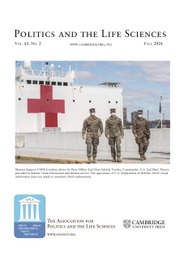Introduction
A large scholarly literature has sought to understand why people do or do not comply with coronavirus disease (COVID-19) public health recommendations, such as masking, vaccinating, and engaging in a wide range of protective measures, like keeping one’s distance from others, avoiding crowded indoor spaces, and avoiding physical contact with others, that have often been labeled physical distancing. For good reason, these behaviors have been essential at managing the COVID-19 pandemic, and this will remain true as societies wrestle with emerging variants in the future.
We focus here on the importance of foundational personality traits, specifically the Big-5 traits, in explaining adherence to public health recommendations and support for related government policy. Existing work on this topic has surprisingly produced mixed results, disagreeing not only over whether a trait is a significant predictor of adherence to public health recommendations but also over the direction of the relationships. It also suffers from two additional limitations. First, the dominance of single, snapshot cross-sectional surveys has limited our ability to observe how personality effects might vary as societal conditions change. If these effects are dynamic, any single survey might give us a misleading impression of the importance of personality traits in a rapidly changing environment.
Second, these works have not been as strongly focused on the “politics” of COVID-19. In political science, research has rightly focused on attitudinal correlates of public health adherence like partisanship (Allcott et al., Reference Allcott, Boxell, Conway, Gentzkow, Thaler and Yang2020; Gadarian et al., Reference Gadarian, Goodman and Pepinsky2021) and trust in medical experts (Merkley & Loewen, Reference Merkley and Loewen2021; Roozenbeek et al., Reference Roozenbeek, Schneider, Dryhurst, Kerr, Freeman, Recchia, van der Bles and van der Linden2020). Personality can also influence people’s preferences toward pandemic policy, such as government restrictions, and may condition the effects of relevant political attitudes. We know that the public’s response to the pandemic has been politically polarizing, but that degree of polarization may be conditional on other individual-level traits like Big-5 personality traits. We are interested here in both the dynamic and conditional effects of personality on the public’s response to the pandemic. The Big-5 is ideal to use as it is a dominant measure of personality within personality psychology and is one of the few personality constructs that are mostly stable over the lifespan (Gerber et al., Reference Gerber, Huber, Doherty, Dowling, Raso and Ha2011). Meaning, we can measure the relationship between personality and protective behaviors over time throughout the COVID-19 pandemic without worrying whether personality is also changing during the pandemic.
We leverage a rolling cross-sectional survey of over 40,000 adult Canadians conducted from November 2020 to July 2021 to examine the relationships of the Big-5 personality traits to COVID-19 risk perceptions, protective behavior, and lockdown-related policy preferences. Canada is a useful case for the study of personality traits and COVID-19. We know that the Big-5 framework is a reliable construct for understanding personality across countries and languages (Benet-Martínez & John, Reference Benet-Martínez and John1998; McCrae et al., Reference McCrae, Costa, Del Pilar, Rolland and Parker1998; McCrae & Costa, Reference McCrae and Costa1997) and is the most widely used personality measure. Canada had a pandemic experience situated between the United States and Europe. Canadian authorities at the federal and provincial levels took a similar suppression approach to COVID-19, implementing restrictions on travel, gatherings, and nonessential businesses and services with declining epidemiological conditions, as opposed to mitigation approaches that focused on voluntary efforts to protect vulnerable populations (e.g., Sweden) and containment approaches that pursued eradication through strict border controls and contact tracing (e.g., New Zealand). Deviation from this dominant approach did occur in some provinces at some times, but Canada’s policy response was broadly aligned with the European and (blue-state) American experiences.
At the same time, the Canadian political elite, at least through the period of our survey fielding, was in a broad state of consensus about the seriousness of COVID-19, as was true in most European countries, although not in the United States. Lockdown restrictions and mask mandates were implemented by both Conservative and Liberal/NDP premiers and not a single Conservative MP cast doubt on the pandemic in any fashion in its early stages (Merkley et al., Reference Merkley, Bridgman, Loewen, Owen, Ruths and Zhilin2020). As doubt started to creep in, intransigent Conservative legislators were disciplined. Notwithstanding this elite consensus, polarization has bubbled under the surface, with left-right differences in threat perceptions and policy preferences that grew as the pandemic progressed (Merkley & Loewen, Reference Merkley and Loewen2021). Elite cues and polarization have not dominated COVID-19 politics as they have in the United States, but partisan and ideological differences do still matter in Canada, offering a useful venue to examine the intersection of personality and politics as it relates to COVID-19.
Our analysis shows that personality traits are consistently, if modestly, related to COVID-19 risk perceptions, support for government restrictions, and especially people’s willingness to take precautions like distancing or masking. The effect of personality on precautionary behavior is stable as pandemic conditions changed, unlike for risk perceptions and policy beliefs, where effects typically weakened as pandemic conditions improved. Personality also conditions the relationship between political ideology and distrust in experts, and COVID-19 attitudes and behaviors. Conscientiousness, agreeableness, and negative emotionality tend to reduce polarization among individuals, while extraversion increases it. Taken together, our findings suggest a complex intersection of personality, politics, and real-world conditions.
Personality traits and COVID-19 behaviors
Work connecting personality traits and (political) behaviors has largely focused on the personality traits of the Big-5. The five traits of the Big-5 are openness to experience, conscientiousness, extraversion, agreeableness, and emotional stability. As reported by Gerber et al. (Reference Gerber, Huber, Doherty and Dowling2011, p. 267), the five traits are defined as the following. Extraversion: “energetic approach toward the social and material world.” Agreeableness: “contrasts a prosocial and communal orientation toward others with antagonism.” Conscientiousness: “socially prescribed impulse control that facilitates task- and goal-directed behavior.” Emotional stability: “contrasts even-temperedness with negative emotionality.” Openness to experience: “the breadth, depth, originality, and complexity of an individual’s mental and experiential life.”
Openness to experience is associated with higher creativity, curiosity, and important behaviors such as high-risk health behavior (Booth-Kewley & Vickers, Reference Booth-Kewley and Vickers1994; George & Zhou, Reference George and Zhou2001). Conscientiousness is associated with organizational traits, such as being dutiful, reliable, and avoiding high-risk health behaviors (Hampson & Colman, Reference Hampson and Colman1995). Extraversion is associated with being more sociable and active. Agreeableness is related to altruistic attitudes and behaviors, including social trust and health behaviors such as substance use and risky sexual behavior (McCrae & Costa, Reference McCrae, Costa and Wiggins1996; Vollrath et al., Reference Vollrath, Knoch and Cassano1999). Emotional stability, often defined as negative emotionality (Gerber et al., Reference Gerber, Huber, Doherty, Dowling, Raso and Ha2011; John et al., Reference John, Naumann and Soto2008), is related to emotionality and a person’s impulse control concerning emotions (Abe & Izard, Reference Abe and Izard1999).
Big-5 personality traits are related to a wide range of political attitudes and behaviors. Liberal identification is associated with higher levels of openness and conscientiousness and lower levels of emotional stability (Cooper et al., Reference Cooper, Golden and Socha2013; Gerber et al., Reference Gerber, Huber, Doherty, Dowling and Ha2010; Jonason, Reference Jonason2014; McCrae & Costa, Reference McCrae and Costa1997). Higher levels of agreeableness are associated with Democratic Party identification in the United States (Mondak & Halperin, Reference Mondak and Halperin2008), although they can vary slightly based on race (Gerber et al., Reference Gerber, Huber, Doherty, Dowling, Raso and Ha2011). Other traits of the Big-5, such as extraversion, have more mixed evidence concerning ideological identification (Gerber et al., Reference Gerber, Huber, Doherty, Dowling and Ha2010; Jonason, Reference Jonason2014; Krieger et al., Reference Krieger, Becker, Greiff and Spinath2019). Comparing between countries, openness is the most generalizable (Vecchione et al., Reference Vecchione, Schoen, Castro, Cieciuch, Pavlopoulos and Caprara2011) for political ideology, but there is still variation between countries on how Big-5 traits predict political participation (Weinschenk, Reference Weinschenk2017).
Higher levels of openness to experience are associated with higher levels of political participation (Mondak et al., Reference Mondak, Hibbing, Canache, Seligson and Anderson2010, Vecchione & Capara, Reference Vecchione and Caprara2009). For voting specifically, higher levels of extraversion are related to higher voter turnout, even when controlling for other impactful factors such as income and education level (Gerber et al., Reference Gerber, Huber, Doherty, Dowling, Raso and Ha2011). High agreeableness is also related to higher reports of voting (Gerber et al., Reference Gerber, Huber, Doherty, Dowling, Raso and Ha2011). Other types of participation, such as political resistance, are also related to Big-5 traits. High agreeableness is related to avoidance of attitude incongruent information, and high extraversion is related to defense of existing political views (Valli & Nai, Reference Valli and Nai2023). Group attitude change is less likely when extraversion and conscientiousness are high (Gastil et al., Reference Gastil, Black and Moscovitz2008). Related to views of “the other side,” high extraversion and agreeableness are related to less negative views of the opposing party (Webster, Reference Webster2018). Importantly, traits of the Big-5, such as agreeableness, are related to policy attitudes; people who are high in agreeableness tend to have more liberal policy attitudes (Gerber et al., Reference Gerber, Huber, Doherty, Dowling and Ha2010).
Big-5 personality traits should also help explain COVID-19 perceptions and behaviors. We focus on three dimensions in this manuscript: the threat people perceive from COVID-19, their willingness to engage in a variety of protective behaviors like avoiding contact and physically distancing, and their support for government restrictions such as border and business closures and restrictions on the size of social gatherings. These dimensions reflect three important dimensions in reactions to the pandemic through attitude change, behavior change, and policy preference change, all of which factor into understanding how individuals are responding to the context of the pandemic.
The overwhelming focus of prior research has been on establishing a connection between Big-5 traits and protective behaviors. All five traits have been implicated, but the balance of findings has been more consistent for some traits than others. Our strongest expectations relate to agreeableness and conscientiousness. Highly agreeable individuals, those who are more caring and considerate, should be more willing to take behaviors that protect others from harm and to follow norms around such behavior (Turiano et al., Reference Turiano, Hill, Graham, Mroczek, Turiano, Hill, Mroczek, Ryff and Krueger2019). Most research has found this indeed to be the case (Aschwanden et al., Reference Aschwanden, Strickhouser, Sesker, Lee, Luchetti, Stephan, Sutin and Terracciano2020; Blagov, Reference Blagov2021; Chan et al., Reference Chan, Moon, Savage, Skali, Torgler and Whyte2021; Condie et al., Reference Condie, Northstone, Major-Smith and Halstead2024; Peters et al., Reference Peters, Götz, Ebert, Müller, Rentfrow, Gosling and Matz2023; Qian & Yahara, Reference Qian and Yahara2020; Rammstedt et al., Reference Rammstedt, Lechner and Weiß2022; Zajenkowski et al., Reference Zajenkowski, Jonason, Leniarska and Kozakiewicz2020; Zettler et al., Reference Zettler, Schild, Lilleholt, Kroencke, Utesch, Moshagen, Böhm, Back and Geukes2022; Zuffianò et al., Reference Zuffianò, Caprara, Zamparini, Calamandrei, Candini, Malvezzi and de Girolamo2023).
At the same time, highly conscientious individuals—prone to diligence and self-discipline—should be more willing to follow health guidelines and engage in protective behavior. Indeed, past work has found conscientiousness to be connected to more adherence to health recommendations (Hampson & Friedman, Reference Hampson and Friedman2008) and norm-following behavior (Hill & Roberts, Reference Hill and Roberts2011). The balance of existing research has found a positive effect on protective behaviors (Aschwanden et al., Reference Aschwanden, Strickhouser, Sesker, Lee, Luchetti, Stephan, Sutin and Terracciano2020; Blagov, Reference Blagov2021; Brouard et al., Reference Brouard, Vasilopoulos and Becher2020; Carvalho et al., Reference Carvalho, Pianowski and Gonçalves2020; Clark et al., Reference Clark, Davila, Regis and Kraus2020; Qian & Yahara, Reference Qian and Yahara2020; Volk et al., Reference Volk, Brazil, Franklin-Luther, Dane and Vaillancourt2021; Zettler et al., Reference Zettler, Schild, Lilleholt, Kroencke, Utesch, Moshagen, Böhm, Back and Geukes2022).
Existing research has presented a more mixed case for negative emotionality, openness, and extraversion. Negative emotionality should push in the same direction, incentivizing the adoption of protective behaviors through heightened anxiety and worry about COVID-19 (more on this below). Negative emotionality is a predictor of fear of disease and germ avoidance (Duncan et al., Reference Duncan, Schaller and Park2009). Existing work has tended to find positive associations (Blagov, Reference Blagov2021; Qian & Yahara, Reference Qian and Yahara2020; Volk et al., Reference Volk, Brazil, Franklin-Luther, Dane and Vaillancourt2021), but the record is more mixed on this trait (see Aschwanden et al., Reference Aschwanden, Strickhouser, Sesker, Lee, Luchetti, Stephan, Sutin and Terracciano2020).
Similarly, openness to experience should be associated with protective behaviors. People who are higher in openness should be more adaptive to new ways of behaving (e.g., pandemic guidelines like social distancing) because of their general openness to new information and experiences. Political psychology has demonstrated a consistent connection between openness to experience and left-wing ideology (Gerber et al., Reference Gerber, Huber, Doherty, Dowling and Ha2010; McCrae & Costa, Reference McCrae and Costa1997; Van Hiel et al., Reference Van Hiel, Kossowska and Mervielde2000). We could see an association between this trait and protective behaviors working through its effect on ideology, although we do not test this mediating relationship here. Most work has recovered positive associations (Aschwanden et al., Reference Aschwanden, Strickhouser, Sesker, Lee, Luchetti, Stephan, Sutin and Terracciano2020; Clark et al., Reference Clark, Davila, Regis and Kraus2020; Qian & Yahara, Reference Qian and Yahara2020; Rammstedt et al., Reference Rammstedt, Lechner and Weiß2022; Zettler et al., Reference Zettler, Schild, Lilleholt, Kroencke, Utesch, Moshagen, Böhm, Back and Geukes2022), but some research has found the opposite (Chan et al., Reference Chan, Moon, Savage, Skali, Torgler and Whyte2021).
The least conclusive trait is extraversion. There is a clear enough case for a negative association here. Introverted individuals, less inclined to socialize in person with others, should be more willing to engage in protective behavior since the social costs of physical distancing are lower for them. Curiously, existing work has shown a mix of negative (Blagov, Reference Blagov2021; Brouard et al., Reference Brouard, Vasilopoulos and Becher2020; Carvalho et al., Reference Carvalho, Pianowski and Gonçalves2020; Chan et al., Reference Chan, Moon, Savage, Skali, Torgler and Whyte2021; Clark et al., Reference Clark, Davila, Regis and Kraus2020) and positive relationships (Aschwanden et al., Reference Aschwanden, Strickhouser, Sesker, Lee, Luchetti, Stephan, Sutin and Terracciano2020; Qian & Yahara, Reference Qian and Yahara2020; Rammstedt et al., Reference Rammstedt, Lechner and Weiß2022; Zettler et al., Reference Zettler, Schild, Lilleholt, Kroencke, Utesch, Moshagen, Böhm, Back and Geukes2022). Our theoretical expectation is a negative relationship.
H1: There are positive associations between protective behaviors and the Big-5 traits, except for extraversion, where the association should be negative.
There has not been the same amount of scholarly attention linking the Big-5 traits to other attitudes and behaviors. Expectations are more ambiguous for threat perceptions. We have no reason to expect that agreeableness, conscientiousness, or extraversion will shape how people process the risk posed by COVID-19. Their adoption of protective behavior relates to either their willingness to follow rules and norms (for conscientiousness and agreeableness) or the social costs of such behavior (for extraverts).
However, if openness to experience leads to higher adherence to public health recommendations owing to left–right polarization on COVID-19, it stands to reason that this emerges, at least in part, from a fundamental divergence between how the left and right evaluate the threat posed by the pandemic (see Panish et al., Reference Panish, Ludeke and Vitriol2023). Similarly, individuals who score high in negative emotionality are more anxious in nature, which will be reflected in their risk perceptions. We expect these people to take protective behaviors precisely because they are more likely to perceive a serious threat from the pandemic since perceived threat can influence political attitudes (Brandt et al., Reference Brandt, Turner-Zwinkels, Karapirinler, Van Leeuwen, Bender, van Osch and Adams2021; Schlipphak, Reference Schlipphak2024).Footnote 1
We see the logic connecting the Big-5 to pandemic policy preferences, such as for lockdowns and government restrictions, in much the same way as for protective behaviors. The highly agreeable support restrictions to protect people, the highly conscientious follow recommendations from trusted health experts, the negatively emotional support these policies to lower their own risk of infection and death, and the highly open follow left-leaning political orientations, while lockdowns impose disproportionate social costs on extraverts.
H2: There are positive associations between risk perceptions and two of the Big-5 traits: negative emotionality and openness to experience.
H3: There are positive associations between lockdown support and the Big-5 traits, except for extraversion, where the association should be negative.
We also examine descriptively how the relationships between our explanatory variables and our outcomes change over the course of the first half of 2021 as the Delta wave receded in Canada and vaccines began their rollout. Expectations are not entirely obvious, and mixed results based on the personality trait in question may be expected (Baker & Merkley, Reference Baker and Merkley2023). On the one hand, we might expect personality effects to strengthen as epidemiological conditions worsen, as some work has found that some of the Big-5 traits strengthened over the course of the pandemic (Rudolph & Zacher, Reference Rudolph and Zacher2023; Sutin et al., Reference Sutin, Stephan, Luchetti, Aschwanden, Lee, Sesker and Terracciano2022). In this case, those with prosocial personality traits (e.g., those who are more agreeable, open, and conscientious) are more attentive to changing conditions and more likely to change their beliefs and behaviors to protect others and to better align with public health guidelines and with normative expectations.
On the other hand, it is possible that personality differences could weaken as conditions worsen (Kyle et al., Reference Kyle, Ford and Willroth2024). Some work has shown that personality effects are attenuated in “strong” situations where there is less flexibility for voluntary adherence to public health recommendations, including the COVID-19 pandemic (Kyle et al., Reference Kyle, Ford and Willroth2024). There is more room for personality differences when government restrictions force adherence (Götz et al., Reference Götz, Gvirtz, Galinsky and Jachimowicz2021) or when perceived norms constrain voluntary behavior (Ludeke et al., Reference Ludeke, Vitriol, Larsen and Gensowski2021). Because we see arguments for both directions, we treat this as a research question.
RQ1: Do the effects of personality traits grow or weaken as pandemic conditions improve (i.e., lower cases and higher vaccination rate)?
Finally, personality traits may moderate the effects of other important political psychological characteristics. We focus our attention on two of particular importance: ideology and expert distrust. Scholars, particularly in the United States, have noticed that the public’s response to the COVID-19 pandemic was deeply polarized along partisan and ideological lines (Allcott et al., Reference Allcott, Boxell, Conway, Gentzkow, Thaler and Yang2020). Although partisan identity does not seem to carry as much weight in explaining COVID-19 attitudes and beliefs in Canada (Merkley et al., Reference Merkley, Bridgman, Loewen, Owen, Ruths and Zhilin2020), ideology certainly plays a role, with ideological conservatives being more skeptical of the risk posed by COVID-19 (Pennycook & Rand, Reference Pennycook and Rand2022), and less likely to take precautions like masking and distancing (Merkley & Lowen, Reference Merkley and Loewen2021).
It is also clearly the case that one’s trust in experts and the scientific community is important in understanding adherence to public health recommendations. Persuasion requires people to trust communicators (Lupia & McCubbins, Reference Lupia and McCubbins1998). Although most Canadians trust experts, for a sizable number of people, this trust is qualified, and there remains a small group of intense distrusters. Distrust in experts has been linked to lower risk perceptions, less protective behavior, more misinformation endorsement, and less interest in COVID-19 information (Merkley & Loewen, Reference Merkley and Loewen2021; Hartmann & Müller, Reference Hartmann and Müller2023). These effects rival, if not exceed ideology, in the Canadian case at least.
Notwithstanding these effects, there is a lot of variation left to explain. Many, if not most, conservatives and those more skeptical of experts perceived some level of threat from COVID-19, took precautions, and supported government restrictions. Understanding who those groups of accessible conservatives and distrusters are is important if we want to dampen polarization in response to public health emergencies.
Personality may be one important source of this variation. As we noted above, Big-5 traits influence COVID-19 behaviors by heightening people’s sensitivity to threat (in the case of negative emotionality), increasing their likelihood of following norms (in the case of agreeableness and conscientiousness), or changing the social costs of adherence to health recommendations (in the case of extraversion). These dynamics can suppress or intensify the link between ideology or expert distrust on COVID-19 attitudes and behaviors. For example, a conscientious conservative may be less inclined to follow her ideological impulses on COVID-19 when confronted with COVID-19 rules and norms, while less conscientious conservatives feel no such constraint. When personality traits interact with political predispositions, it leaves some people cross-pressured between their political commitments and their desire to adopt prosocial or risk-minimizing behaviors.
The effects of personality and ideology or distrust may be additive, in the sense that conscientiousness bolsters things like protective behaviors equally for the left and the right or trusters and distrusters. We suspect that this is not the case because of a fundamental asymmetry between these groups. The intense volume of information from experts, and the consistent dissemination of elite cues from left-leaning parties like the Liberals and NDP (Merkley et al., Reference Merkley, Bridgman, Loewen, Owen, Ruths and Zhilin2020) could have offered sufficient motivation for left-leaning, expert trusters to adopt politically consistent positions on the pandemic, despite being less anxious or less concerned with conforming to societal norms. There was likely little more that prosocial or risk-averse personality traits could do to move the needle any further. For conservatives and distrusters, the political environment was not as conducive to public health adherence, so prosocial and risk-averse personality traits are able to help compensate.Footnote 2
We take these associations as descriptive only. We do not manipulate personality, ideology, or expert distrust here. Indeed, the causal relationships between these concepts and our outcomes are likely complex. As we described above, work has found associations between ideology and the Big-5, particularly openness to experience (predicting liberalism) and, to a lesser degree, conscientiousness (predicting conservatism). Ideology and expert distrust may act as mediators to some degree.Footnote 3 However, we also believe there is an important interactive effect. Personality can act as a constraint on the connection between these mediators when they have their own unique causal connection to our outcomes of interest. Conscientious, agreeable, and emotionally unstable citizens, as well as introverted citizens, are each more likely to take precautionary behaviors for reasons that have nothing to do with their levels of trust in experts or their ideology.Footnote 4
This expectation is not unique to the relationship between personality traits and COVID-19 behaviors. For example, Mehlhaff et al. (Reference Mehlhaff, Ryan, Hetherington and MacKuen2024) argue that the connection between partisanship and protective behaviors like masking was weaker among those who were scared about becoming sick, a variable that is also caused by partisanship. Dowd-Arrow et al. (Reference Dowd-Arrow, Burdette and Smith2023) show that partisan differences are larger among older respondents, but it is also true that age causes partisan identity, with younger respondents more likely to identify as Democratic (Munger, Reference Munger2022). Sylvester (Reference Sylvester2021) finds that education moderates the effect of partisanship on COVID-19 knowledge, with partisan gaps shrinking among the highly educated, but education also causes Democratic identification (Grossman & Hopkins, Reference Grossmann and Hopkins2024). Mediators and moderators cannot always be so neatly disentangled.
At a minimum, we expect agreeableness, conscientiousness, negative emotionality, and extraversion to matter more for conservatives and distrusters, with the first three traits exhibiting a depolarizing effect and the last trait doing the opposite. Or, to put it another way, the dampening effect of conservative ideology and expert distrust on risk perceptions, protective behaviors, and lockdown support should be weaker with rising levels of the Big-5, except for extraversion.
H4: The effects of conservative ideology and expert distrust on pandemic attitudes and behaviors should be weaker among those with high levels of the Big-5 traits, except for extraversion, where the associations should be stronger.
Our analysis precedes in three stages. First, we examine the baseline associations between our Big-5 traits, controlling for demographics across all of our survey waves (H1–H3). Second, we observe whether these associations vary as pandemic conditions evolved through our period of fielding (RQ1). Finally, we test whether our Big-5 traits weaken or strengthen polarization in COVID-19 attitudes and behaviors by ideology and expert distrust (H4). Our findings suggest we need to take seriously the dynamic and conditional effects of personality on health-related attitudes and behaviors.
Data and method
We use a rolling cross-sectional survey fielded by the Media Ecosystem Observatory between November 2020 and July 2021 to survey 42,196 adult Canadian citizens using the sample provider Dynata. This survey was run in 22 consecutive waves, with each wave using quotas to match population benchmarks on gender; region (Atlantic Canada, Quebec, Ontario, and West); age (18–34, 35–54, and 55+ years); and language (English and French). Data and code are available upon request.Footnote 5
Outcomes
We focus our attention on three principal outcomes: COVID-19 risk perceptions, protective behaviors, and preferences for government lockdowns. Risk perceptions are measured with an additive 0–1 index of two items asking respondents to evaluate how serious a threat COVID-19 is to themselves and to other Canadians (response categories: very serious, somewhat serious, not very serious, and not at all serious). Our index has a Cronbach’s α score of 0.80 and loads on one factor.
Protective behaviors are measured by asking respondents whether they have taken a variety of action over the past week as a result of the pandemic (avoiding bars, restaurants, and crowded places; avoiding in-person contact with friends, family, and acquaintances; maintained 2 meters distance from others; avoided domestic travel; and wore a mask). We do not have concrete expectations about how personality traits differentially affect protective behaviors, so we create an additive 0–1 index. Our Cronbach’s α for our protective behaviors index is 0.82, and all items load on one factor.
Finally, we measure lockdown preferences by asking respondents a pair of questions asking the extent of respondents’ disagreement with three statements: (1) “Nonessential businesses should be allowed to open their doors to the general public” (reverse-coded); (2) “The Canadian border should be open to nonessential travel” (reverse-coded); and (3) “There should be fines for people attending public gatherings of more than five people.”
These three measures reflect policy that was consistently implemented through our period of fielding at different levels of stringency across the Canadian provinces. The Canadian border was closed to nonessential travel throughout the entirety of the fielding. Closures of nonessential businesses were routinely implemented as part of government-mandated lockdowns during pandemic waves, although the precise businesses affected varied by province and over time. Restrictions on gatherings similarly varied in intensity as epidemiological conditions worsened and improved, with fines for gatherings anywhere more than 10 people depending on the severity of the epidemiological conditions. There was considerable debate on when closures and gathering restrictions should be implemented (i.e., well in advance of a predicted wave or as hospitalizations grew) and when, if ever, they should be relaxed—in essence, a debate between those that wanted to manage COVID-19 and those who preferred the goal of elimination.
We create an additive 0–1 index from these items. This represents a drop of around 0.67 standard deviations (SDs) in this index. The Cronbach’s α score for our lockdown index is 0.57, while all items load on one factor. Our outcome measures are standardized in the analyses that follow. Online Appendix Figure S1 shows how our outcome measures varied over the pandemic.
Personality traits
We measure Big-5 personality traits with the Big Five Inventory-2 Short Form (BFI-2-S), which asks respondents to evaluate their personality traits across 30 different items. This form is a shortened version of the 60-item BFI-2. The BFI-2 has the ability to measure not just the Big-5 traits, but also sub-facets within those traits in a way that is both easy to understand for respondents and minimizes acquiescence bias (Soto & John, Reference Soto and John2017). The shortened version of the BFI-2 was designed to maximize content validity with a more limited number of items drawn from the BFI-2. Nonetheless, the BFI-2-S has been shown to retain over 90% of the internal consistency of the BFI-2 (Soto & John, Reference Soto and John2017). The BFI-2 is included in all 22 waves from November 2020 to July 2021 that we feature. Our α reliability scores for our five domain scales range from 0.61 for openness to 0.80 for negative emotionality.Footnote 6 Our personality trait scales are standardized in the cross-sectional analyses that follow for ease of interpretation.
Ideology and expert distrust
We measure ideology using a standard 0–10 left–right self-placement scale. Expert distrust is measured by a series of questions asking respondents to rate their level of trust or distrust in experts, scientists, doctors, and professors (strongly trust, somewhat trust, neither, somewhat distrust, and strongly distrust).Footnote 7 Questions, including our control variables reported below, are asked in all 22 waves that include the BFI-2 from November 2020 to July 2021.
Estimation
For H1–H3, we estimate pooled models regressing each of our outcomes on our Big-5 personality traits, a series of control variables: age, education, income, gender, and region, and wave fixed effects. More details on the measurement of our variables can be found in Online Appendix Table S1. Over the course of fielding, survey respondents were sometimes able to retake the survey, occasionally by design. Consequently, we cluster our standard errors based on unique respondent IDs.
We use multilevel modeling to evaluate whether the effects of the Big-5 change as pandemic conditions evolve to evaluate RQ1. We focus on two dimensions that changed considerably over the fielding of the surveys: COVID-19 cases and the aggregate vaccination rate. COVID-19 case data are from the World Health Organization.Footnote 8 At the start of fielding on November 22, 2020, new COVID-19 cases increased from ~5,000 daily to 8,800 daily by January 2021. Cases then fell to ~2,500 by the beginning of March before rising yet again to more than 9,500 daily cases in April 2021. Daily cases stayed above 8,000 until mid-June when they fell to under 1,000. We gathered data on vaccination rates from Our World in Data.Footnote 9 At the start of fielding, no Canadians were vaccinated. The vaccination rate stayed at a trivial level until March 2021, when vaccinations opened to vulnerable populations. The vaccination rate increased from 3% to almost 33% between March and April 2021, then to almost 70% by June 2021.
Our context-level variables are common to respondents surveyed on the same day, so these respondents can be seen as nested within those dates. It is appropriate to use multilevel modeling in this context. However, we treat the survey wave as the level variable because our fielding did not allow for an even and representative rolling cross-section. As in, some days systematically have fewer respondents from harder-to-reach quota groups, as those quotas are filled for a given survey wave. We thus use the wave-based average for our Level 2 variables. Our results do not appreciably change when using the date as our level variable. These variables are demeaned in the analyses that follow.
We estimate a series of linear mixed models using maximum likelihood: one for each personality trait per outcome, where we interact a personality trait with both COVID-19 cases and the aggregate vaccination rate. The slope of the personality trait is allowed to randomly vary across groups (i.e., survey wave). We include level 1 controls for education, income, age, and region. We cluster standard errors by wave.
Finally, we test H4—the moderation effects of personality on expert distrust and ideology—with a pair of models for each outcome that interacts with ideology and expert distrust with negative emotionality, conscientiousness, agreeableness, and extraversion. All models control for education, income, age, gender, and region. Our models with the ideology interaction introduce a control for religiosity, and models with the expert distrust interaction additionally include controls for ideology, science literacy, conspiratorial thinking, social trust, and government distrust. Again, we discuss how we measure our variables in Online Appendix Table S1. We use respondent-clustered standard errors for these analyses.
Results
Figure 1 displays the results for our pooled models. The full estimates can be found in Online Appendix Table S3. The left-most panel presents the results for COVID-19 risk perceptions. We find that negative emotionality, openness, and agreeableness are all associated with risk perceptions, the first two of which are consistent with H2. An SD increase in negative emotionality is associated with a 0.16 SD increase in risk perceptions (p < 0.001). The same increase in agreeableness and openness is associated with 0.10 and 0.04 SD increases in risk perceptions, respectively (p < 0.001). Extraversion and conscientiousness are not significantly associated with risk perceptions.
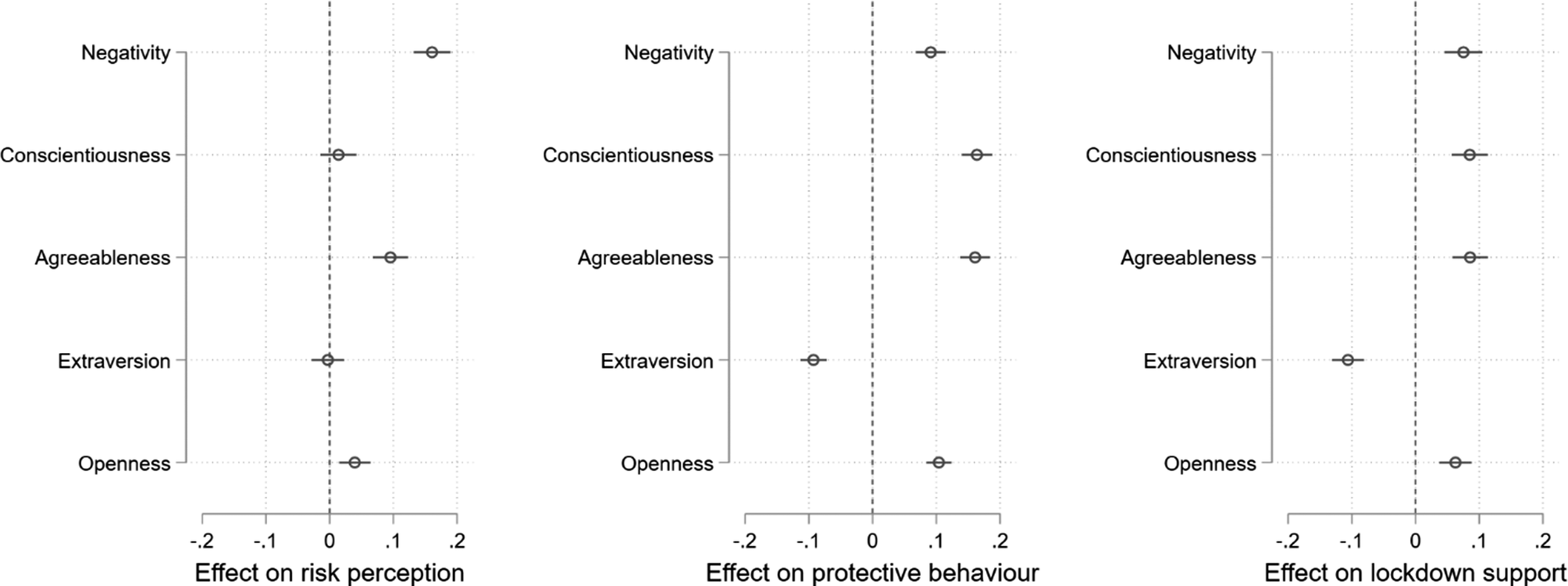
Figure 1. Coefficient estimates for associations between personality traits and risk perceptions (left panel), protective behavior (center panel), and lockdown support (right panel). Here, 99.9% confidence intervals are shown.
The center panel of Figure 1 shows the results for protective behaviors. All of the Big-5 traits are associated with these behaviors, consistent with H1. An SD increase in negative emotionality is associated with a 0.09 SD increase in precaution taking in support (p < 0.001). This same increase in conscientiousness and agreeableness is associated with 0.16 SD increases in protective behavior (p < 0.001). An SD increase in extraversion, in contrast, is associated with a 0.09 decrease in protective behavior (p < 0.001), while an SD increase in openness is associated with a 0.10 SD increase in this measure (p < 0.001).
Finally, the right-side panel of Figure 1 presents the results for lockdown preferences. Again, all Big-5 traits are associated with lockdown preferences, consistent with H3. SD increases in negative emotionality, conscientiousness, and agreeableness are all associated with 0.08 SD increases in lockdown preferences (p < 0.001). An SD increase in extraversion is associated with a 0.11 SD decrease in lockdown preferences (p < 0.001), while the same increase in openness is associated with a 0.06 increase in lockdown preferences (p < 0.001).
All told, personality traits have consistent associations with attitudes and behaviors related to COVID-19 at magnitudes that approach other factors we know matter, like ideology and trust in experts. Personality appears to matter much more in understanding protective behavior, while negative emotionality stands out for risk assessments.Footnote 10 Associations with lockdown support, however, are consistently weaker.
The dynamic effects of personality
It does appear that some of these effects are responsive to changing pandemic conditions, with the vaccination rate being the most consistent moderator. This is especially true for three of the Big-5: conscientiousness, openness, and especially agreeableness. Figure 2 displays mean risk perceptions. The gap between levels of agreeableness and openness appears to collapse after the second COVID-19 wave and with the rollout of vaccines. Emotional negativity seems to matter even more. Figures 3–5 display the mean differences across respondents with high and low levels of each trait, alongside the vaccination rate and COVID-19 cases. Figure 2 = Figure 4 displays mean lockdown preferences. We see the collapse of personality differences almost across the board in the final COVID-19 wave with the vaccine rollout. There also appears to be some widening of differences during COVID-19 waves. In sharp contrast, personality differences are remarkably stable for protective behaviors (Figure 3).
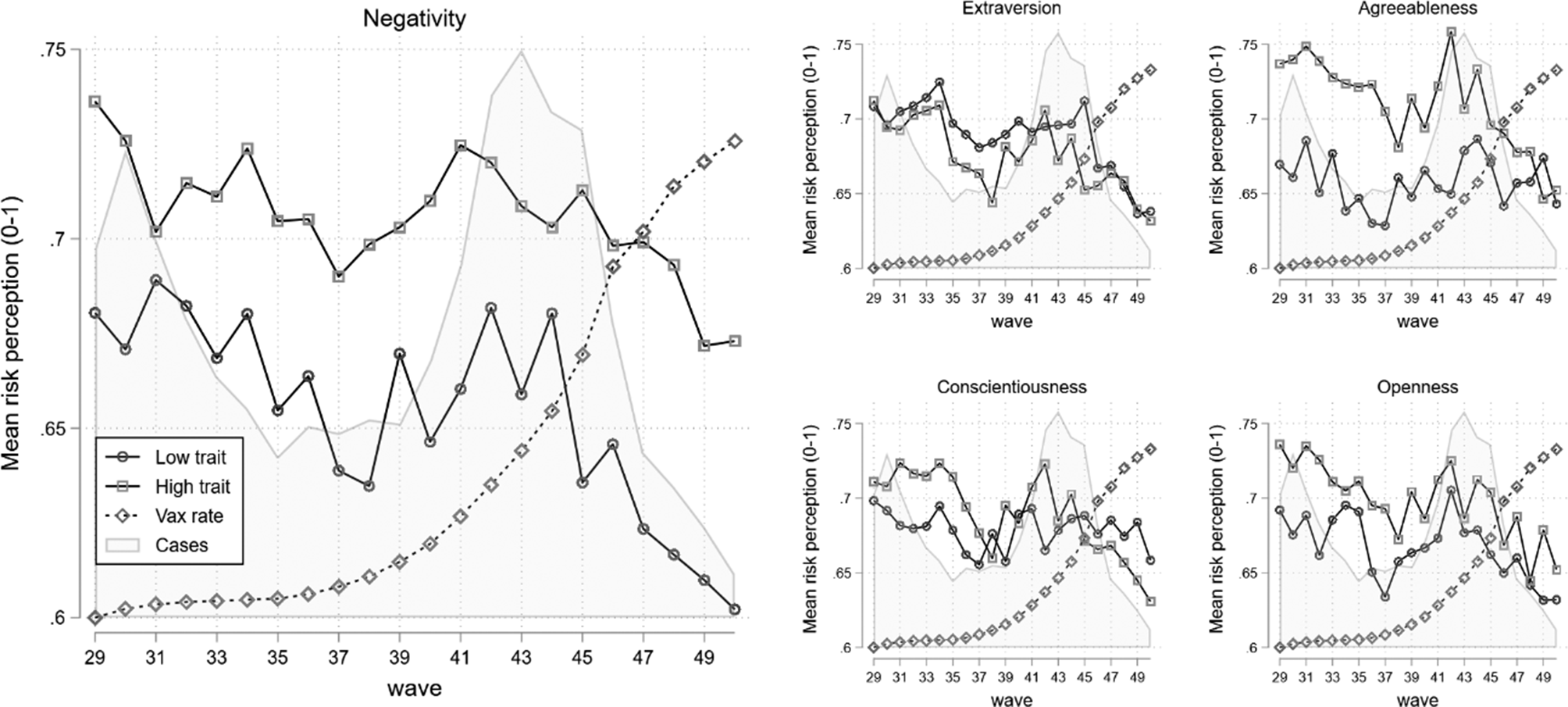
Figure 2. Mean risk perceptions for respondents with high or low levels of personality traits: emotional negativity (left), extraversion (top-center), agreeableness (top-right), conscientiousness (bottom-center), and openness (bottom-right). COVID-19 caseload is represented by the shaded area and vaccination rate by the diamond series.
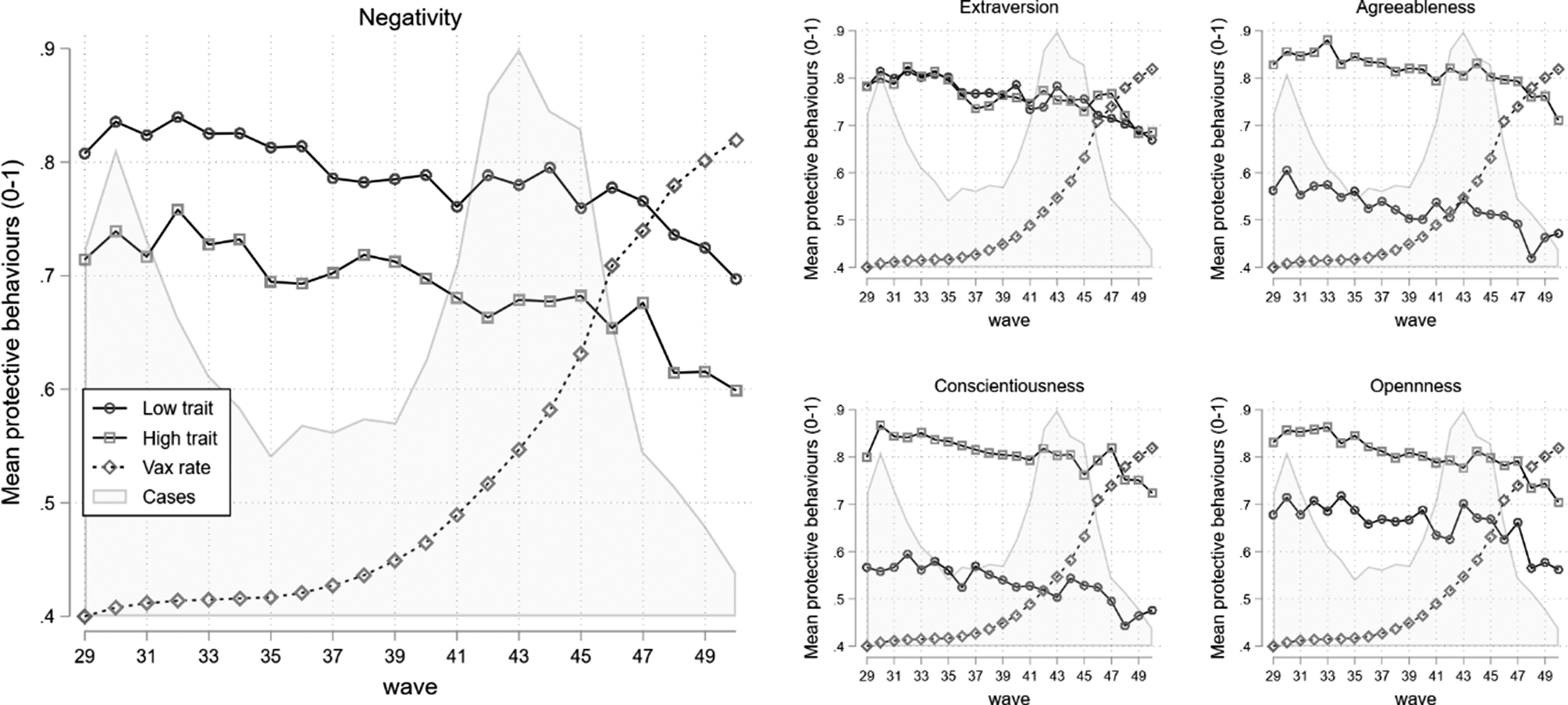
Figure 3. Mean protective behaviors for respondents with high or low levels of personality traits: emotional negativity (left), extraversion (top-center), agreeableness (top-right), conscientiousness (bottom-center), and openness (bottom-right). COVID-19 caseload is represented by the shaded area and vaccination rate by the diamond series.
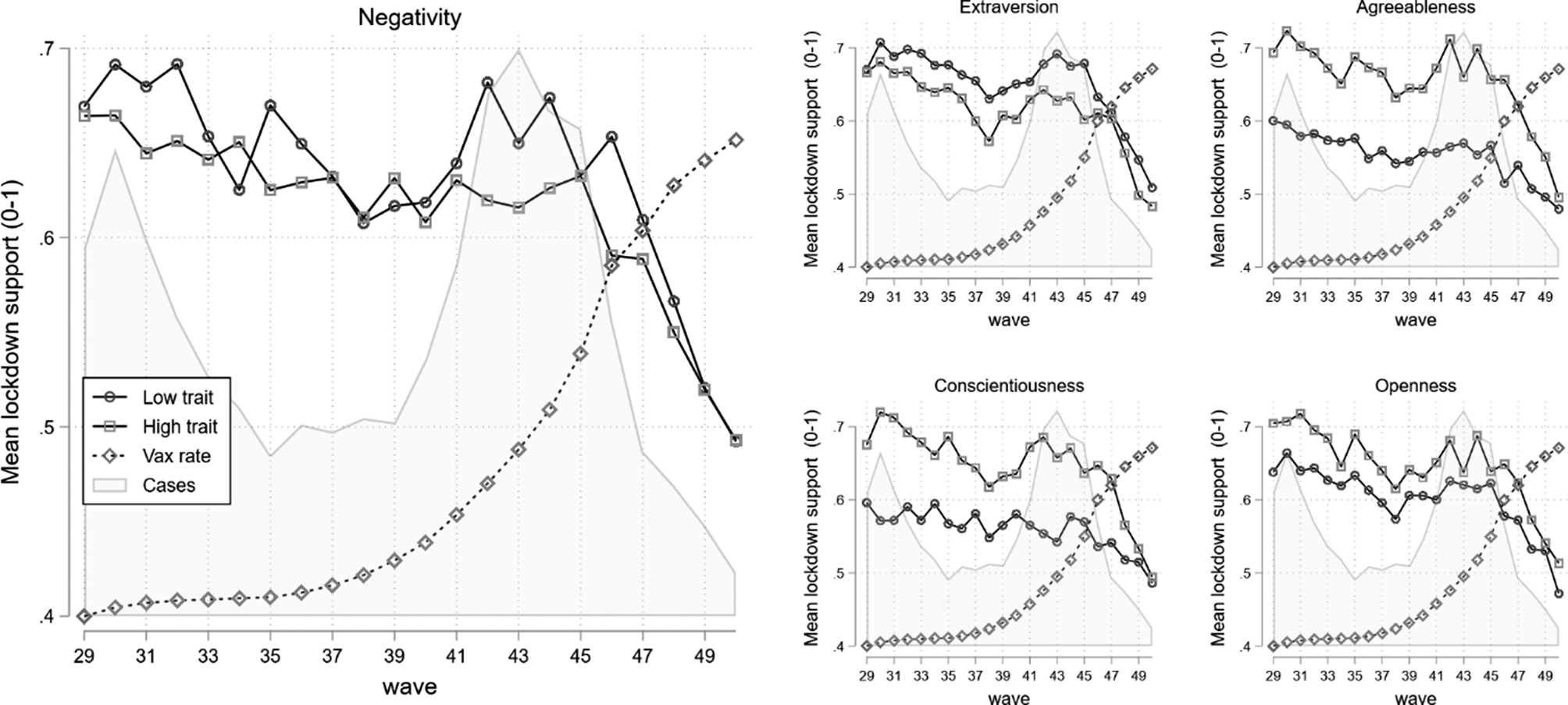
Figure 4. Mean lockdown support for respondents with high or low levels of personality traits: emotional negativity (left), extraversion (top-center), agreeableness (top-right), conscientiousness (bottom-center), and openness (bottom-right). COVID-19 caseload is represented by the shaded area and vaccination rate by the diamond series.
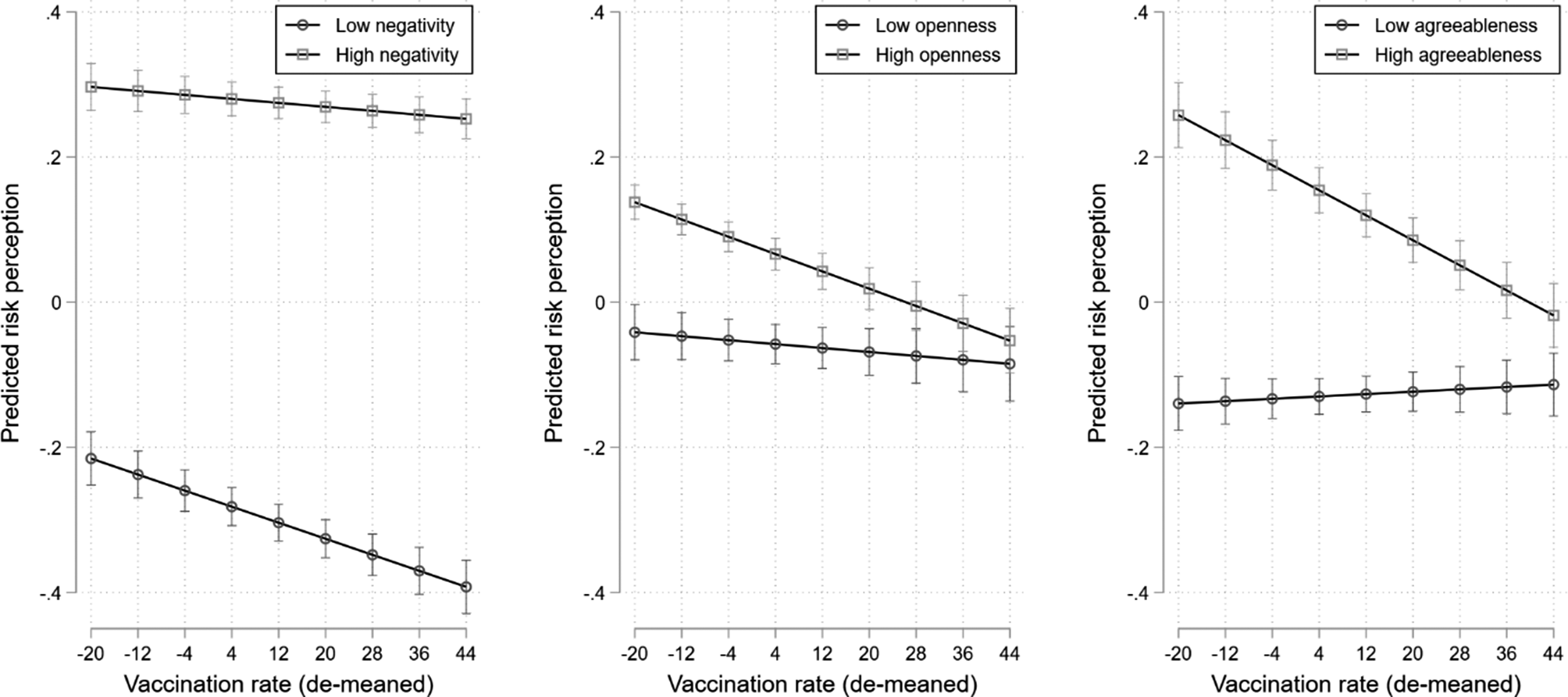
Figure 5. Predicted risk perception across the vaccination rate by high and low negative emotionality (left), openness (center), and agreeableness (right). Here, 95% confidence intervals are shown. Vaccination rate is demeaned. High and low scores of the personality traits are the 95th and 5th percentiles of the index.
We present our estimates from the multilevel models for more formal tests of these differences, controlling for the effects of demographic characteristics. The model estimates can be found in Online Appendix Tables S6–S8. We focus on three significant personality predictors of risk perceptions: negative emotionality, openness, and agreeableness. The predictions are displayed in Figure 5. In no case does the effect of these traits vary depending on the caseload, but they are responsive to the vaccination rate. The case of negative emotionality is more consistent with H6. As conditions improve with a growing vaccination rate, the effects of personality grow as those low in negative emotionality are related to lower risk perceptions by 0.15 SDs, which is much lower among those high in this trait (0.05 SDs). Regardless of epidemiological conditions, there remained a sizable difference in risk perceptions depending on one’s level of negative emotionality. Even at the lowest level of the vaccination rate, the difference was 0.51 SDs, which grew by 25% with a rising vaccination rate.
The cases of openness and agreeableness are consistent with the diminishing importance of these traits with the increases in the vaccination rate. The highly open ones have lower risk perceptions by 0.19 SDs, compared to only 0.04 SDs for the less open ones. However, ultimately the gap between these groups dropped from 0.18 SDs at low levels of the vaccination rate to 0.03 SDs at the highest level of the rate during our fielding. The same is true for agreeableness. The highly agreeable have lower risk perception by 0.28 SDs with a rising vaccination rate, compared to only 0.03 SDs for the less agreeable. The gap between these two groups decreased from 0.40 SDs at the lowest vaccination rate to 0.09 SDs at the highest vaccination rate during our fielding.
Unlike the case of risk perceptions, the effects of personality on protective behaviors are remarkably stable. There was only one significant interaction. As COVID-19 cases rise, the gap between the open and less open falls, driven by increased protective behaviors by the latter. These results are displayed in Online Appendix Figure S2. Ultimately, however, the rule for protective behavior is stability.
Lockdown support shows very different patterns—one of overwhelming instability as the pandemic evolved, perhaps accounting for the weaker effects observed in Figure 1. This instability was particularly apparent for conscientiousness and agreeableness. The highly conscientious have reduced lockdown support to 0.42 SDs as the vaccination rate rises, compared to 0.25 SDs for those scoring low on that trait. This reduces the gap between these two groups from 0.34 to 0.17 SDs. At the same time, declining cases are related to lower lockdown support among the highly conscientious by 0.41 SDs, compared to 0.15 SDs for those scoring low on the trait. This reduces the gap between these groups from 0.42 to 0.18 SDs. These results are displayed in the top-center and top-right panels of Figure 6. We see virtually identical results for agreeableness, displayed in the bottom-center and bottom-right panels of the figure, both in direction and magnitude. Conscientiousness and agreeableness shape lockdown support roughly twice as much when pandemic conditions are at their worst compared to when they are at their best.
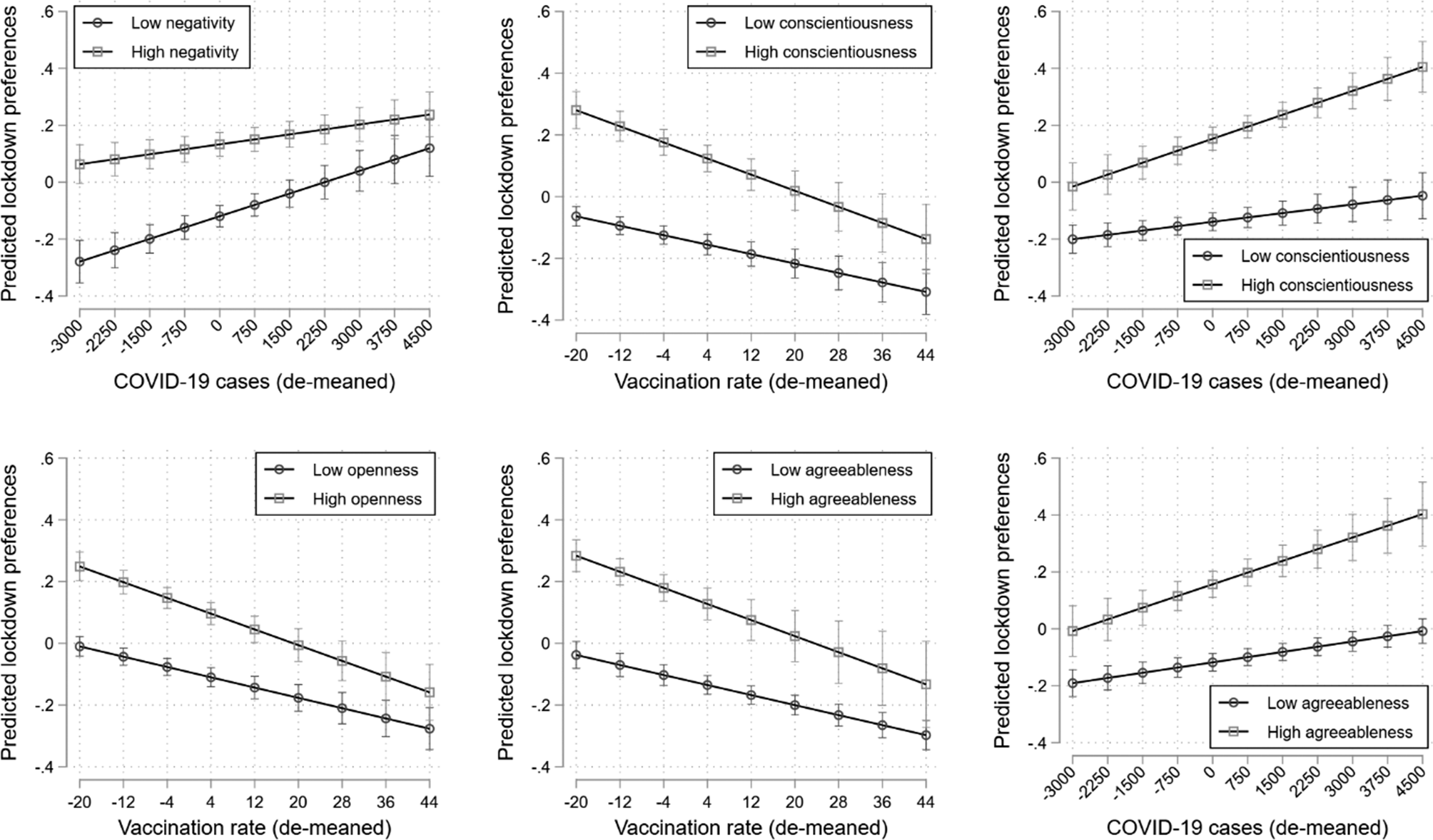
Figure 6. Predicted lockdown preferences by levels of negative emotionality across COVID-19 caseload (top-left); by levels of conscientiousness across the vaccination rate (top-center) and COVID-19 caseload (top-right); by levels of openness across the vaccination rate (bottom-left); by levels of agreeableness across the vaccination rate (bottom-center) and COVID-19 caseload (bottom-right). Here, 95% confidence intervals are shown. Vaccination rate and COVID-19 cases are demeaned. High and low scores of the personality traits are the 95th and 5th percentiles of the index.
The dynamic effects of openness and negative emotionality are more mixed. Lockdown support is lowered by 0.41 SDs among those who are more open, compared to only 0.27 SDs among those who are less open, as the vaccination rate grows, reducing the gap between these groups from 0.26 to 0.11 SDs. There is no significant moderating effect of caseload. These results are displayed in the bottom-left panel of Figure 6. In contrast, lockdown support drops by 0.40 SDs among those with low negative emotionality compared to only 0.18 SDs among those who score high on that trait. Falling cases increase the gap from 0.13 to 0.34 SDs. Generally, the story is one of the declining importance of personality traits as the pandemic recedes, but negative emotionality is a notable exception to this rule—those scoring high on this trait are relatively locked into their risk perceptions and lockdown support.
Ultimately, there is no universal pattern of change in the effects of the Big-5 personality traits across different indicators of pandemic conditions and outcomes of interest, but a few key patterns emerge. The effects of personality traits on policy preferences are more responsive to pandemic conditions (6/10 interactions significant at the 0.05 level) than is the case for risk perceptions (3/6) or protective measures (1/10). The effects of agreeableness (3/6 interactions significant at the 0.05 level) and openness (3/6) are more likely to change in response to pandemic conditions than conscientiousness (2/6), negative emotionality (2/6), and especially extraversion (0/6). It was also more often the case that personality traits weakened in importance as pandemic conditions receded (7/10 significant interactions).
Moderating effects of personality
Finally, we examine the moderating influence of personality on ideology and expert distrust. Our estimates can be found in Table 1. We begin with risk perceptions, where we had the fewest strong expectations of conditional relationships. Negative emotionality is related to lower polarization by the left and right, in line with H4, as displayed in Figure 7c. The gap between the left and right drops from 0.54 to 0.04 SDs with rising levels of negativity. However, contrary to these expectations, conscientiousness (extraversion) increases (decreases) polarization by heightening (reducing) risk perceptions on the left (panels D and E). The gap between the left and right grows (reduces) from 0.09 (0.41) to 0.68 SDs (0.24 SDs) as conscientiousness (extraversion) increases.
Table 1. Estimates for conditional effects analysis
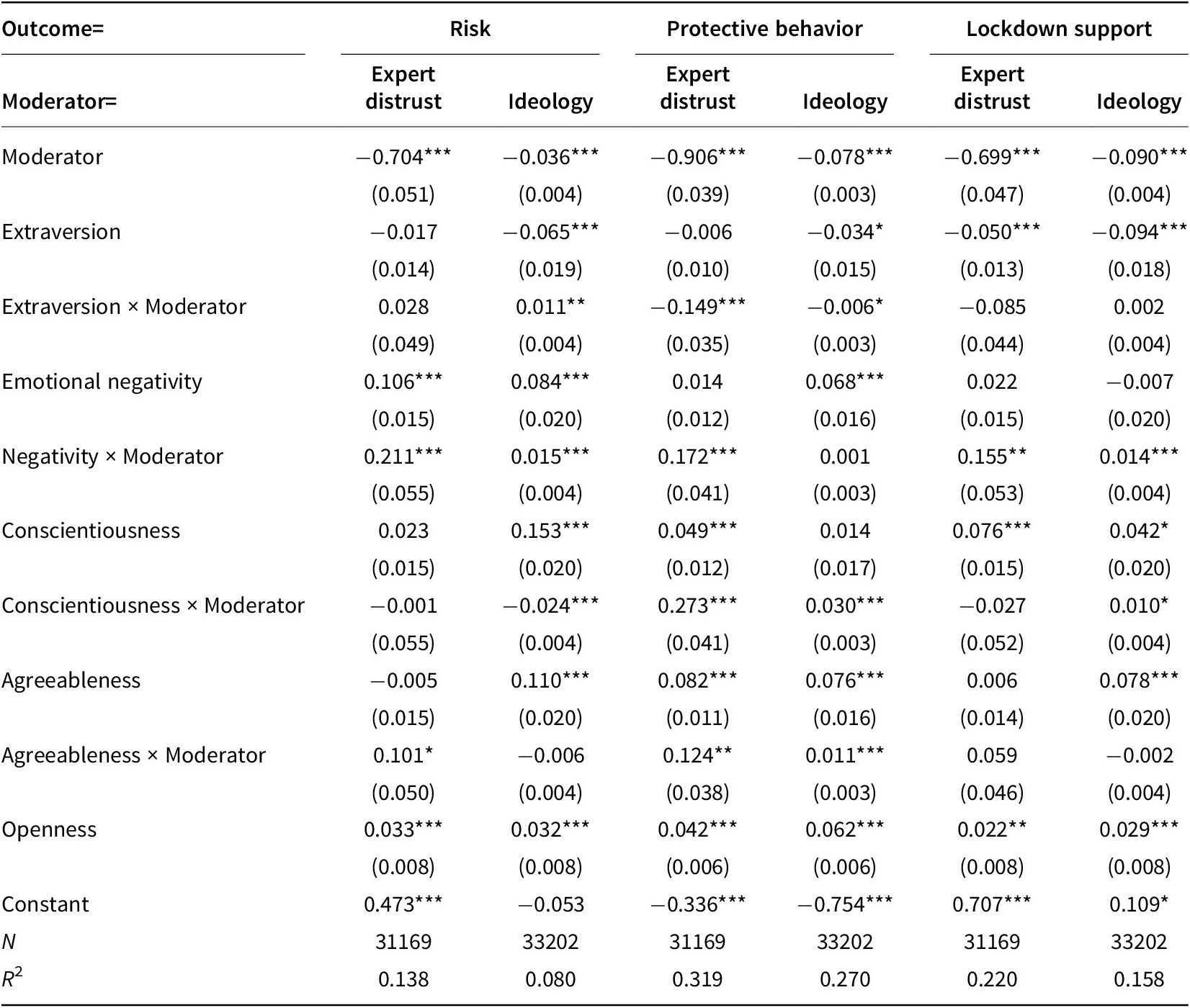
Note: All models control for education, income, age, gender, and region. Our models focusing on ideology introduce a control for religiosity, while expert distrust models additionally include controls for ideology, science literacy, conspiratorial thinking, social trust, and government distrust; respondent cluster-robust standard errors in parentheses; * p < 0.05, ** p < 0.01, *** p < 0.001.
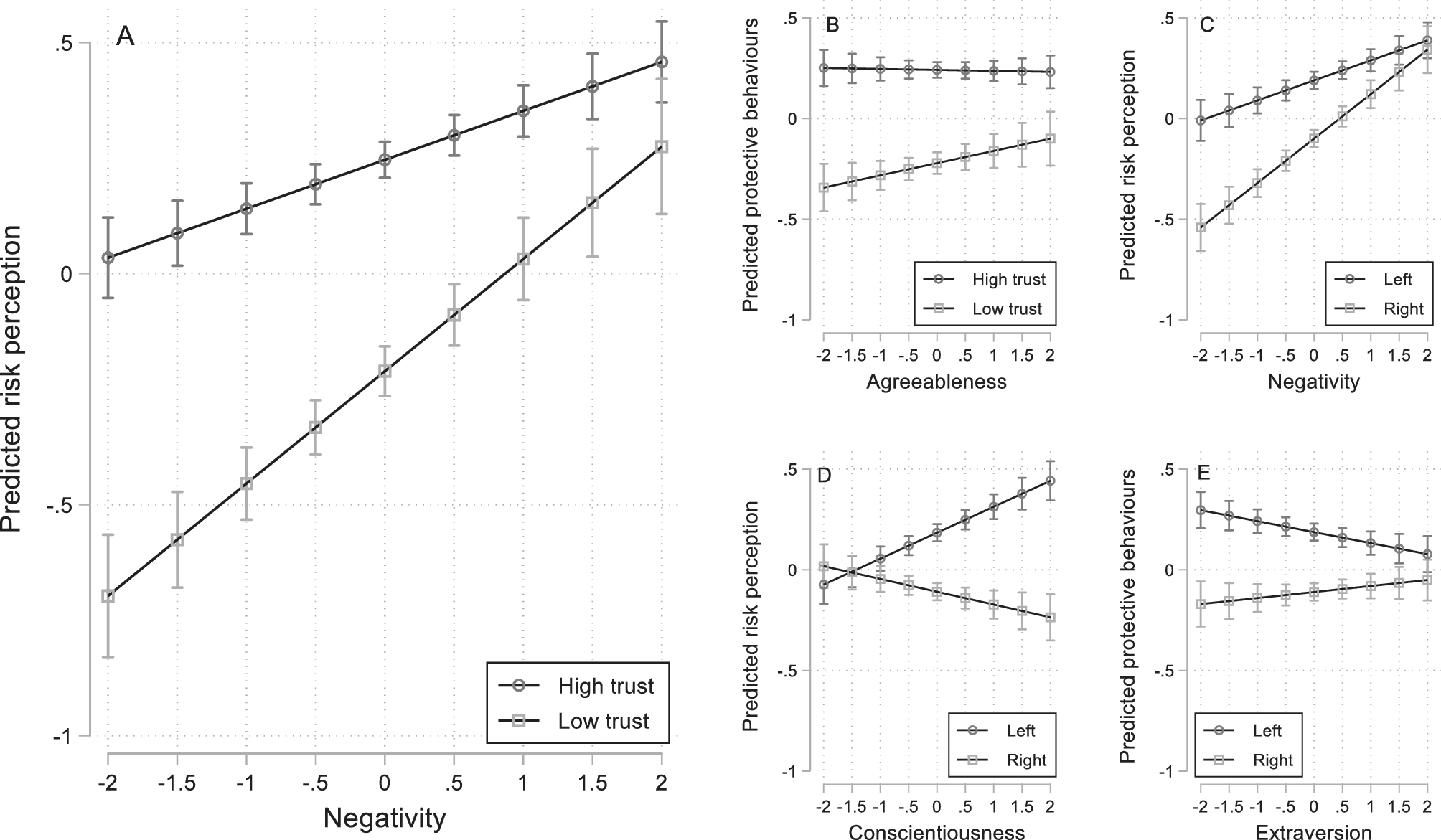
Figure 7. Predicted risk perceptions across negative emotionality (left) and conscientiousness by ideology (top-center) and across negative emotionality by expert distrust (right). Here, 99% confidence intervals are shown. Variables are standardized. High and low scores of the moderators are the 95th and 5th percentiles of the measure.
Expectations were more closely met with expert trust as a moderator, at least for negative emotionality (panel A) and agreeableness (panel B). At the lowest level of negative emotionality, we see a gap between trusters and distrusters of 0.73 SDs, which drops to 0.19 SDs at the highest levels of negative emotionality. The gap between trusters and distrusters drops from 0.59 to 0.33 SDs across levels of agreeableness as well. Negative emotionality and agreeableness were the strongest determinants of risk perceptions among the Big-5, and it appears they suppress the effects of ideology (for negativity alone) and expert distrust in line with H4.
We see more consistent moderation effects for protective behaviors. Three of the four Big-5 traits we examined significantly moderated the effects of ideology at the 0.05 level, with conscientiousness and agreeableness reducing polarization and extraversion increasing it. Across the levels of conscientiousness, the gap between the left and right drops from 1.10 to 0.15 SDs, driven by heightened protective behavior among those on the right (left panel of Figure 8). Across the levels of agreeableness, this gap drops from 0.80 to 0.44 SDs, driven by more protective behavior on the right (center panel). In contrast, the gap between left and right rises modestly from 0.52 to 0.71 SDs across levels of extraversion, driven by less protective behavior on the right (right panel).
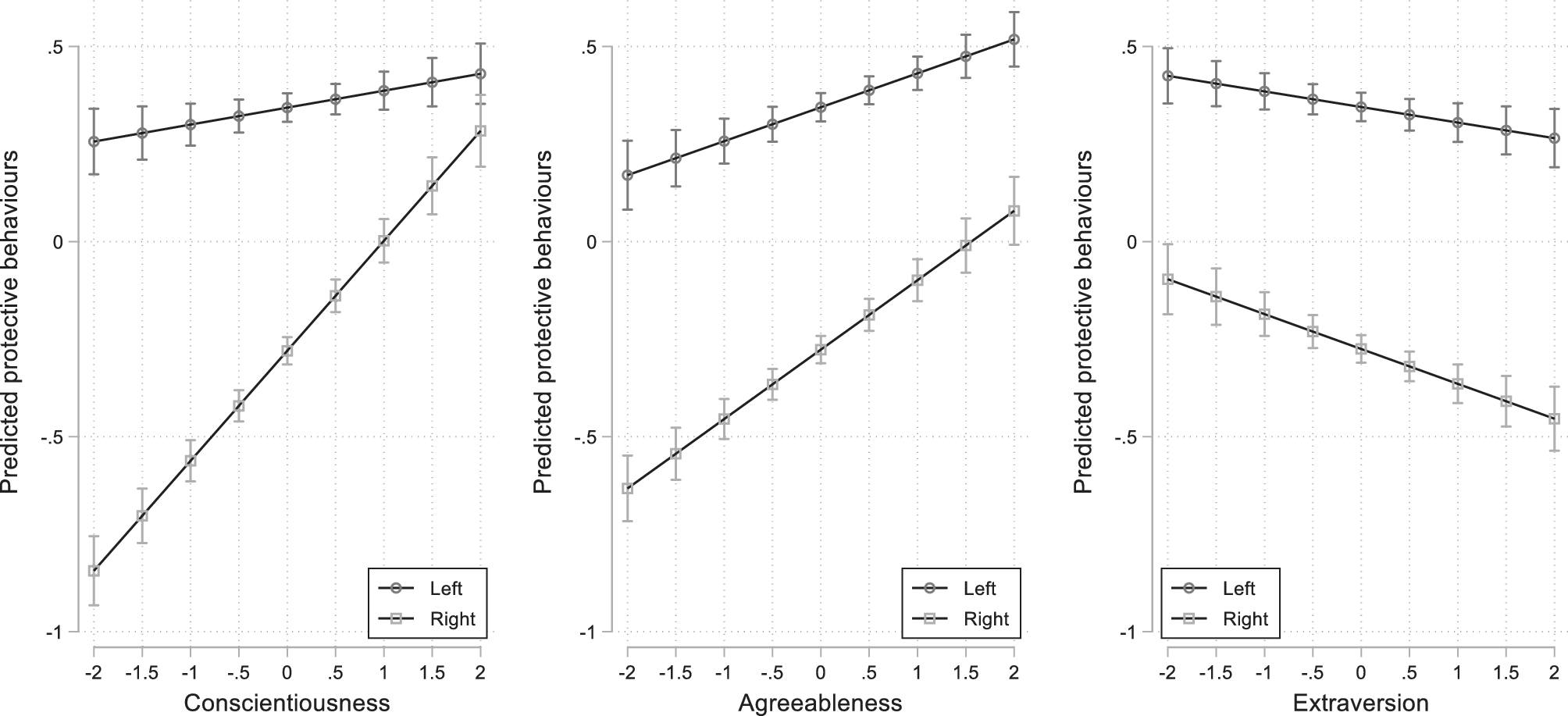
Figure 8. Predicted protective behaviors by left and right across levels of conscientiousness (left), agreeableness (center), and extraversion (right). Here, 99% confidence intervals are shown. Variables are standardized. High and low scores of the moderators are the 95th and 5th percentiles.
We see even more striking findings for expert distrust. All four Big-5 traits we examine moderate the effect of expert trust in ways that are consistent with H4. Across levels of negative emotionality, we see the gap between trusters and distrusters reduced from 0.82 to 0.36 SDs, driven by heightened protective behavior by distrusters (top-left panel of Figure 9). The gap is reduced from 0.76 to 0.44 SDs across levels of agreeableness, again driven by the heightened protective behavior of distrusters (top-right panel), while conscientiousness is related to a reduction in the gap between trusters and distrusters from 0.96 to 0.24 SDs (bottom-left). Finally, extraversion displays contrary effects that are consistent with H4. The gap grows from 0.40 to 0.78 SDs with this trait (bottom-right). Big-5 personality traits had their strongest effects on precautionary behavior, and they appear to dampen the tendency of the political right and distrusters to reject these behaviors. The exception is extraversion, which intensifies these divides.
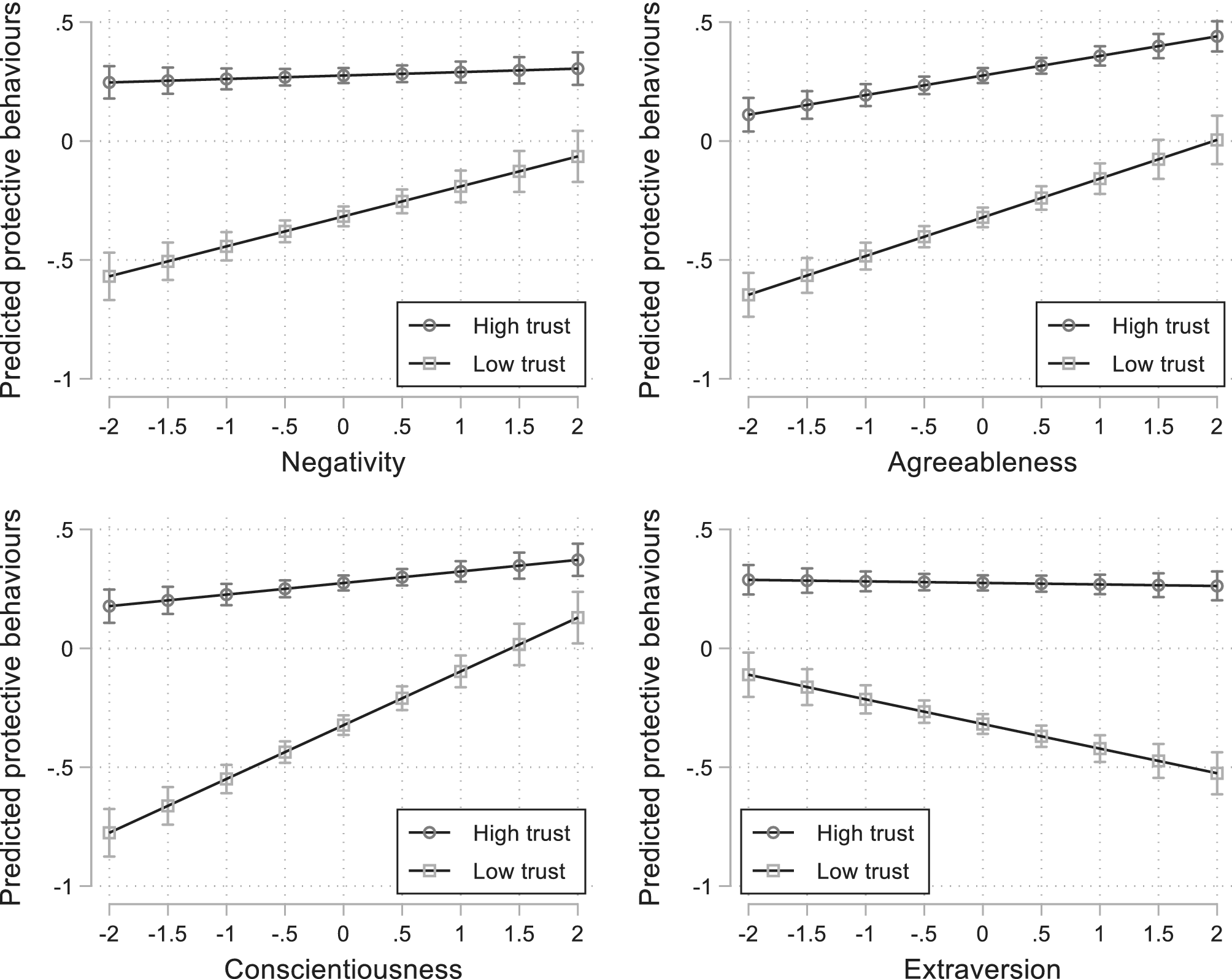
Figure 9. Predicted protective behaviors by level of expert distrust across negative emotionality (top-left), agreeableness (top-right), conscientiousness (bottom-left), and extraversion (bottom-right). Here, 99% confidence intervals are shown. Variables are standardized. High and low scores of the moderators are the 95th and 5th percentiles.
Finally, we turn to lockdown support. We see more evidence of moderation than for risk perceptions, but not as much as for protective behavior. Both negative emotionality and conscientiousness moderate the effects of ideology in ways that are consistent with H4. The gap between the left and right decreases from 0.94 to 0.49 SDs for the former (top-left panel of Figure 10) and from 0.87 to 0.57 for the latter (top-right panel). Negative emotionality and extraversion do the same for expert distrust, both consistent with H4. The gap between trusters and distrusters drops from 0.65 to 0.25 SDs across levels of the former (bottom-left panel) and rises from 0.35 to 0.50 SDs for the latter (bottom-right panel).
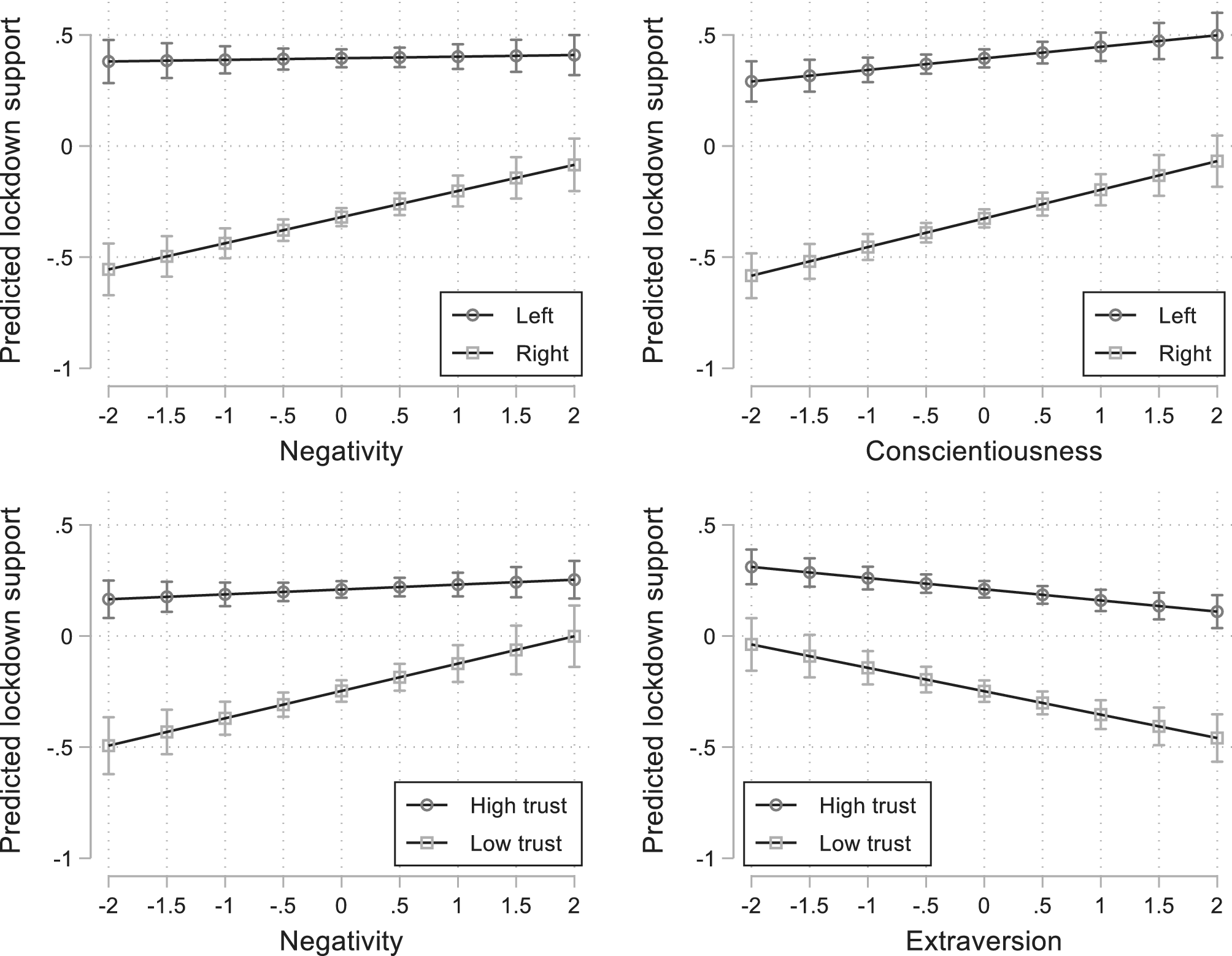
Figure 10. Predicted lockdown support by the left and right across levels of negative emotionality (top-left) and conscientiousness (top-right); by expert distrust across levels of negative emotionality (bottom-left) and extraversion (bottom-right). Here, 99% confidence intervals are shown. Variables are standardized. High and low scores of the moderators are the 95th and 5th percentiles of the measure.
As was the case for overtime dynamics, the moderating influence of personality on political psychological traits like ideology and expert distrust is not fully consistent, but patterns are suggestive. Moderation effects were much more common for protective behavior (7/8 interactions significant at the 0.05 level) compared to lockdown support (4/8) and risk perceptions (5/8). Moderation was also most consistent for negative emotionality (5/6 interactions significant at the 0.05 level), conscientiousness (4/6), and extraversion (4/6), compared to agreeableness (3/6). Finally, we find that of the 16 significant interactions, only two were contrary to H4, which expected conscientiousness, agreeableness, and negative emotionality to dampen polarization and extraversion to heighten it.
Discussion
Understanding who is and is not willing to follow public health guidelines is essential not just for combating the COVID-19 pandemic, but for addressing future public health emergencies as well. It is clear that the trust people have in expert sources is essential in improving adherence to public health recommendations, as are their political commitments, especially if political elites take politically polarizing positions on the emergency in question.
It also appears that personality traits also play an important role in this process. Between November 2020 and July 2021, we found that COVID-19 risk perceptions were notably higher among those who are more emotionally negative, highly agreeable, and who are open to experience. Even more notably, all Big-5 personality traits are strongly linked to people’s willingness to take protective behaviors and consistently to their support for government policy related to restrictions like lockdowns, although at a weaker magnitude. Among the Big-5, only extraversion is negatively related to these outcomes. We find consistent support for H1–H3.
However, the effects of personality traits vary as the pandemic progressed in ways that are inconsistent across outcome variables and traits. Stability is the norm for the relatively strong effects of personality on protective behavior. Instability is more common for risk perceptions and especially support for government restrictions. The effects of conscientiousness, openness, and agreeableness tend to be less stable, and usually in the direction of weakening as pandemic conditions improved, as evidenced by falling caseloads or, most notably, a rising vaccination rate. We cannot take for granted stability in the effects of personality on COVID-19 attitudes and behaviors. These traits—except for negative emotionality—were especially important at the peak(s) of the crisis, which is at odds with other work finding that personality matters when pandemic conditions worsened, at least when restrictions were high (Götz et al., Reference Götz, Gvirtz, Galinsky and Jachimowicz2021).
The effects of personality matter indirectly, as well. They can suppress or intensify differences between people based on their ideological predispositions or their level of trust in experts. These divisions were generally reduced by conscientiousness, agreeableness, and, especially, negative emotionality, and were increased by extraversion. These conditional relationships were especially apparent for precautionary behavior. The upshot is that there are internal differences within the political left and right, and within those who trust experts and those who do not. Moreover, personality-driven differences can cut against the typically polarizing effects of these characteristics. Conscientious, agreeable, emotionally anxious, and introverted conservatives and distrusters are much more amenable to taking steps to protect themselves and others from harm, and to a lesser extent, to support public policy with the same goals.
Policymakers and public health professionals may be able to use these findings to aid in public health messaging strategies, especially those related to protective behaviors. Oftentimes, messaging strategies target people based on life circumstances (e.g., messaging for parents) or blanket public good messaging. Our findings show that personality is related to the protective behaviors in which people engage, even when they run counter to what one might expect based on an individual’s political ideology, especially when pandemic circumstances were notably worse. This makes personality a particularly effective personal characteristic to target public health messaging around since personality may damper surrounding political noise. For example, messaging that targets conscientiousness by expressing the importance of protective behaviors to be diligent and take public health concerns seriously during a peak time of a crisis may be effective even in a conservative person because of the driving effects of conscientiousness.
Theoretically, these results point to the dynamic role of personality. The Big-5 personality traits are stronger predictors of behaviors during worst times of the pandemic compared to milder times of the pandemic. The worst times of the pandemic brought on more uncertainty about conditions, social norms, and safe behaviors. It may be the case that personality traits are stronger predictors of behaviors when people are dealing with heightened uncertainty, whether it be new circumstances, new information, or more complex information. Some preliminary evidence of this exists in the medical field, where the Big-5 personality traits and uncertainty interact to predict diagnostic reasoning, communication with patients, and specialty choices (Borracci et al., Reference Borracci, Ciambrone and Arribalzaga2021; Schneider et al., Reference Schneider, Wübken, Linde and Bühner2014). Future research should examine this, along with the other personality and cognitive factors that can shape risk perceptions and pandemic behaviors, especially when circumstances are changing.
There are some important limitations of these data worth acknowledging. First, we do not have causally identified effects of personality traits on our outcome variables. Exogenously manipulating personality is near impossible, so the threat of omitted variable bias remains. Along similar lines, it is difficult to disentangle relationships between personality, ideology, or expert distrust, and COVID-19 attitudes and behaviors. Personality has small, if inconsistent, effects on ideology and expert distrust, so it can also act as a partial mediator. The COVID-19 pandemic has passed, but future work should try to heighten the salience of certain personality dimensions to see if it suppresses or intensifies the relationship between political beliefs and public health attitudes and behaviors.
Second, our data source is a rolling cross section, so we do not track the same respondents over time. Third, our measure of precautionary behaviors is self-reported by a survey. Existing work is conflicted as to whether self-reported measures of protective behaviors are contaminated by social desirability bias (Daoust et al., Reference Daoust, Bélanger, Dassonneville, Lachapelle, Nadeau, Becher, Brouard, Foucault, Hönnige and Stegmueller2021; Gollwitzer et al., Reference Gollwitzer, Martel, Brady, Pärnamets, Freedman, Knowles and Van Bavel2020), but at a minimum, there will exist a fair amount of slippage between actual behavior and what people say they did. Finally, it is unclear whether these results are generalizable and would be found in other pandemic time points, in future pandemics, or during other types of crises. That being said, the data presented here uniquely allow us to observe how the relationships between personality and COVID-19 outcomes change with epidemiological conditions over a meaningful period of the pandemic and how they vary with other constructs with a high degree of precision, given the sample size. A substantial advance upon existing research dominated by single cross-sectional surveys.
Our results raise some important questions. For instance, why were some traits of the Big-5 more responsive to pandemic conditions than the others? Why does this instability manifest itself most strongly for policy beliefs and risk perceptions? Why does personality condition the effects of expert distrust and ideology more strongly for protective behaviors than risk perceptions and policy attitudes? It is clear, however, that we cannot take for granted stability in the effects of personality traits on COVID-19 attitudes and behaviors. They matter most when conditions are most acute, perhaps a source of the mixed findings in related literature. There does appear to be a personality component to the public’s adherence or lack thereof to public health recommendations and their beliefs in related government policy, but there remain many unanswered questions.
Supplementary material
The supplementary material for this article can be found at http://doi.org/10.1017/pls.2025.10003.
Competing interests
The authors declare none.

